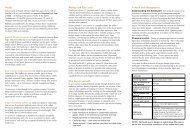Bushland Weeds Manual - Environmental Weeds Action Network
Bushland Weeds Manual - Environmental Weeds Action Network
Bushland Weeds Manual - Environmental Weeds Action Network
Create successful ePaper yourself
Turn your PDF publications into a flip-book with our unique Google optimized e-Paper software.
Weed management in bushland is concerned with much<br />
more than simply the elimination of weeds. The<br />
underlying objective is always the protection and<br />
restoration of diverse natural ecosystems.<br />
South west Western Australia supports one of the<br />
most diverse floras in the world, occurring in intricate<br />
patterns across a variety of landscapes and soils. For<br />
the southern Swan Coastal Plain alone, 1700 native<br />
taxa (species, subspecies and varieties) have been<br />
recorded occurring in at least 30 different plant<br />
communities (Gibson et al. 1994, Keighery 1999b).<br />
Along a 30 m long and 1 m wide transect through a<br />
population of Harlequin Flower (Sparaxis bulbifera)<br />
invading herblands in the Brixton St Wetlands, up to<br />
28 native taxa and 8 introduced taxa may be found.<br />
<strong>Bushland</strong> weed management in the region is often<br />
about working in complex natural systems with a long<br />
history of varying disturbances. There is a need to<br />
recognise that effective weed management among<br />
such diversity begins with knowing and understanding<br />
each site; the distribution of the native plants and the<br />
native plant communities, the patterns of disturbance<br />
and the distribution of weeds. In particular it is<br />
important to recognise the locally serious weeds. Only<br />
then can weed control and management be strategic –<br />
carefully targeted, and tailored to site conditions and<br />
available resources.<br />
Gathering area-specific information<br />
Note: The information listed below is often compiled when bushland<br />
areas are being identified for retention or as part of a management<br />
plan. When such information is not available it should be compiled as<br />
part of the management program.<br />
Vegetation maps<br />
Vegetation maps of particular bushland areas provide<br />
information on the structure and patterns of native<br />
flora across different landscapes and soils (see<br />
vegetation map of Quairading Nature Reserve, Box 3.2).<br />
When carrying out bushland restoration, vegetation<br />
maps, accompanied by a flora list, provide a vital<br />
reference and an important guide to where in the<br />
landscape particular native species occur and the soils<br />
on which they generally grow.<br />
Flora list<br />
Chapter 2 Managing <strong>Weeds</strong><br />
in <strong>Bushland</strong><br />
Some General Principles<br />
A flora list aims to record all taxa known to occur at a<br />
particular site. A comprehensive flora list is a vital<br />
reference for ensuring species not known to occur<br />
naturally at a particular site are never introduced as a<br />
part of bushland restoration – either through planting<br />
or direct seeding.<br />
In addition, flora lists will often indicate the plant<br />
communities and associated soils and landforms where<br />
particular species can be found growing. At Brixton<br />
Street Wetlands for example, such a flora list provided a<br />
guide for appropriate selection of species for direct<br />
seeding trials located along a degraded edge of herbrich<br />
shrublands on damp, heavy clay soils (see direct<br />
seeding case study 5.1). Flora lists should also include<br />
weeds – it is important to know all flora and to be able<br />
to recognise new weeds as soon as they arrive at a site.<br />
Lists will change over time. When our work began at<br />
Shenton <strong>Bushland</strong> 40 species of weeds were recorded.<br />
After three years of working and getting to know the<br />
site, 25 additional weed species had been identified.<br />
Vegetation condition maps<br />
Impacts of disturbances across a bushland can be<br />
recorded in vegetation condition maps. Fire intensity<br />
and frequency, weed invasion, soil disturbance, disease,<br />
rubbish dumping and past vegetation clearances<br />
interact to impact on the species composition, cover<br />
and structure of native vegetation. Vegetation condition<br />
maps aim to reflect the degree of those impacts.<br />
Combined with maps of the distribution of individual<br />
weed species, they are useful tools for carefully<br />
targeting weed control work to protect relatively<br />
undisturbed bushland (Box 2.1). Mapping of vegetation<br />
condition requires knowledge of native flora as well as<br />
familiarity and understanding of the nature of a<br />
particular undisturbed plant community (see Box 7.1 for<br />
details on criteria used to map vegetation condition).<br />
Weed maps<br />
Maps that provide a clear understanding of where the<br />
serious weeds occur across a bushland site are basic<br />
planning tools. They allow for careful targeting of<br />
limited resources and provide the information required<br />
for strategic weed management. They can provide<br />
useful information on the spread of weed populations<br />
over time and also provide basic information on the<br />
effectiveness of control programs. Not all the weeds in<br />
the bushland need to be mapped – only those that have<br />
a serious impact. See Chapter 7 for how to create and<br />
use weed maps and for some of the criteria that can be<br />
used to determine the serious weeds at a particular<br />
site.<br />
Fauna information<br />
Information on the area’s fauna is also useful.<br />
Sometimes weeds can provide habitat or an<br />
opportunistic food source for native animals. A list of<br />
the known fauna in a bushland can help determine this<br />
at a particular site. Gradual removal of such weeds over<br />
time may be required while animals find alternative<br />
habitat or food sources. For example, dense stands of<br />
Watsonia can provide important habitat for Bandicoots<br />
in the Perth area.<br />
5



